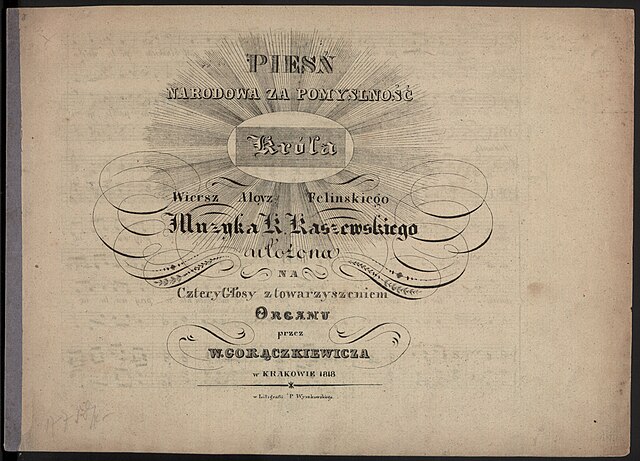Top Qs
Timeline
Chat
Perspective
Boże, coś Polskę
Polish religious and patriotic song From Wikipedia, the free encyclopedia
Remove ads
Boże, coś Polskę is a Polish Catholic patriotic hymn. When Poland gained its independence in 1918, it competed with Mazurek Dąbrowskiego for the right to be the national anthem of Poland.[1]

Its title is usually given as God Save Poland in English,[2] as a hint to God Save the King.[3] Literally it is translated as "Lord, who Poland..." from the first lines of the hymn "Boże! Coś Polskę przez tak liczne wieki / Otaczał blaskiem potęgi i chwały...", "Lord! Who for so many ages enclosed Poland with the light of power and glory...".
The original text was authored by Alojzy Feliński published in Gazeta Warszawska on July 20, 1816, to the glory of the monarch of the Congress Poland, i.e., the Emperor of Russia Alexander I, which since 1818 was known under the title Pieśń narodowa za pomyślność króla. It caused a good deal of controversy and already in the next year the last line of the refrain was unofficially sung as Naszą ojczyznę racz nam wrócić, Panie ("deign to give us back our homeland, Lord") instead of Naszego króla zachowaj nam Panie! ("Save our king for us, Lord"). Over time the text was subject to other changes. In February 1817 a hymn Hymn do Boga o zachowanie wolności (incipit: O Ty! którego potężna prawica...) by Antoni Gorecki was published. From the latter two stanzas were included into Boże, coś Polskę.[3]
The initial melody by Captain Jan Nepomucen Kraszewski from the 4th Infantry Regiment was quickly forgotten and replaced by well-known church melodies: first Bądź pozdrowiona Panienko Maryjo (Hail, Virgin Mary), and later Serdeczna Matko (Dear Mother).[3]
As the hymn became a declaration of disobedience to the occupying Russian authorities, so it was banned in the Russian partition in 1862.[3] It was widely sung by the insurgents of the Uprising of 1863, earning it the nickname "La Marseillaise of 1863".[3] Later, Boże, coś Polskę was sung during the Nazi occupation of Poland and during martial law in Poland during the 1980s.[3]
Remove ads
Text sampler
Summarize
Perspective

Polish
Translations
Remove ads
References
Wikiwand - on
Seamless Wikipedia browsing. On steroids.
Remove ads
